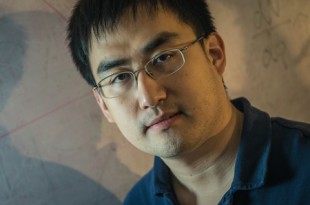David Ruth
713-348-6327
david@rice.edu
Jade Boyd
713-348-6778
jadeboyd@rice.edu
Rice physicist Wei Li named Sloan fellow
HOUSTON — (Feb. 23, 2015) — Rice University physicist Wei Li is among the 126 American and Canadian scholars awarded 2015 Sloan Research Fellowships. The prestigious fellowships, awarded annually since 1955 by the Alfred P. Sloan Foundation, are given to early career scientists and scholars whose achievements and potential mark them as rising stars.
Li, assistant professor of physics and astronomy, will use the Sloan funding to research a novel kind of matter referred to as “quark-gluon plasma” at the world’s most powerful particle accelerator, Europe’s Large Hadron Collider. The plasma, a soup of subatomic particles called quarks and gluons, forms at temperatures greater than 2 trillion degrees; it last occurred in nature in the split seconds following the Big Bang.
“In addition to helping us learn about the state of our early universe, studies of quark-gluon plasma may provide us with new hints about mysterious interactions that are mediated by the strong force at extremely high temperatures,” Li said.
The particle physics community is abuzz as the Large Hadron Collider prepares to restart in March following two years of maintenance and upgrades. The collision energy at restart will be 13 trillion electron volts, almost double the energy of the collider’s initial three-year run. The collider accelerates beams of subatomic particles to near light-speed and then smashes them together head-on.
Li, whose research lies at the intersection of particle physics and nuclear physics, will work on an experiment that collides high-energy beams of lead nuclei.
“My students and I are preparing to visit the collider in late May or early June, when the machine is ready to deliver new data to the CMS (Compact Muon Solenoid) experiment,” Li said.
The CMS is a 13,000-ton cylinder filled with equipment for detecting and measuring the exotic, short-lived particles produced by the collisions.
“We share the same hardware as the high-energy folks who discovered the Higgs boson, but we are exploring a different type of physics,” Li said.
Li, who also won an early career award from the Department of Energy in May, has been collaborating for months with hundreds of other physicists to create the algorithms and software capable of recognizing the collisions that create quark-gluon plasma and storing the data from those collisions for later analysis.
“I am very excited to be recognized as a Sloan Research Fellow, and I am very grateful for the tremendous work of my brilliant students and the generous support I have received from colleagues at Rice and across the CMS collaboration,” Li said. “As physicists, we always strive to push the frontier of the research, but we are keenly aware that this only happens because of the generous support of organizations like the Sloan Foundation.”
Sloan fellows work in chemistry, computer science, economics, mathematics, evolutionary and computational molecular biology, neuroscience, ocean sciences and physics. According to the foundation, 43 fellows have received a Nobel Prize in their respective fields, 16 have won the Fields Medal in mathematics, 14 have won the John Bates Clark Medal in economics and 65 have received the National Medal of Science since the program was founded.
The complete list of winners appears at www.sloan.org/sloan-research-fellowships/2015-sloan-research-fellows.
-30-
High-resolution IMAGES are available for download at:
https://news2.rice.edu/files/2014/05/0515_WEILI-09-lg.jpg
CAPTION: Wei Li
CREDIT: Jeff Fitlow/Rice University
http://cds.cern.ch/record/1474902/files/CMSrealSize5000_final_darker.jpg
CAPTION: CMS detector
CREDIT: CERN
A complete list of 2015 Sloan Research Fellows is at:
http://www.sloan.org/sloan-research-fellowships/2015-sloan-research-fellows
Located on a 300-acre forested campus in Houston, Rice University is consistently ranked among the nation’s top 20 universities by U.S. News & World Report. Rice has highly respected schools of Architecture, Business, Continuing Studies, Engineering, Humanities, Music, Natural Sciences and Social Sciences and is home to the Baker Institute for Public Policy. With 3,920 undergraduates and 2,567 graduate students, Rice’s undergraduate student-to-faculty ratio is just over 6-to-1. Its residential college system builds close-knit communities and lifelong friendships, just one reason why Rice is highly ranked for best quality of life by the Princeton Review and for best value among private universities by Kiplinger’s Personal Finance. To read “What they’re saying about Rice,” go here.



